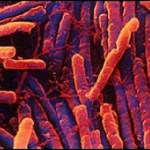feces
By Hollingsworth John and Karen, U.S. Fish and Wildlife Service [Public domain], via Wikimedia Commons
Researchers are spending a lot of time exploring how the microbes living in our guts impact our health. In a new study published in Cell Reports, researchers wanted to know how the gut microbes of wild brown bears changes between summer and hibernation. They discovered that during the summer, the microbial species present in the gut are more diverse and are of the type that helps store energy. In fact, when the research team gave the microbes to rodents, the rodents gained…
Image from www.antforum.nl
Many species of ants are known for being rather clean by disposing of their dead outside of the nest and placing other wastes, like bits of food, in refuse chambers. Dr. Tomer J. Czaczkes (University of Regensburg) was surprised therefore to see "dark patches" build up in plaster nests that housed black garden ants (Lasius niger). Dr. Czaczkes suspected that these dark patches might actually be feces. He tested this hypothesis by adding food coloring to their diet. Perhaps not surprisingly, the dark patches changed to shades of blue and red.
Several theories…
Image of C. difficile from BBC News.
You may recall a prior post about a dog that could smell when patients were infected with Clostridium difficile. C. difficile causes about 14,000 deaths per year in the United States. Recent breakthroughs in understanding gut microbes have led to the successful treatment of C. difficile in patients. Fecal transplants, the transfer of feces from a healthy person, has been life-saving for some patients for whom medical treatments are not effective or for recurrent infections. Listen to Billie's story here. To date, feces have been…
Close up of one of the Pipe Creek Sinkhole coprolites showing structures interpreted as hair (A) and a close-up of a mold in the coprolite thought to have been made by a hair (B). From Farlow et al, 2010.
Time and again I have stressed that every fossil bone tells a story, and, in a different way, so do coprolites. They are small snapshots of a moment in the life of an organism, often preserving bits of their meals, and while they may not get top billing in museum halls, they are among the most pungent reminders that weird and wonderful organisms really did live during the remote past. As…
Feeling stressed? Run down? Is your face not as chipper and toned as it might be? Of course you are. We all are from time to time, particularly as we journey into middle age and beyond. So what better than a bit of pampering at the spa? There's nothing like a soothing facial to get the skin toned and the face all relaxed. But what kind of facial? What is best to get that blood flowing, those dead skin cells exfoliated, and that skin all toned and tight?
Bird poop, of course. Just check out the Ten Thousand Waves spa in New Mexico and its Japanese Nightingale Facial:
This is our signature…
Researchers at the New England Aquarium have stepped into a totally new method of studying Atlantic's threatened population of right whales - collecting and analyzing floating feces to test the population's health!
I didn't know whales ate corn!
Right whales got their name because they were the "right" whale to catch during whaling's hey day, when exterminating an entire species was jolly good form. Despite rigorous efforts to protect them against whaling interests, including Japanese "research" vessels, right whale populations have not increased noticeably in the last 65 years. In…

